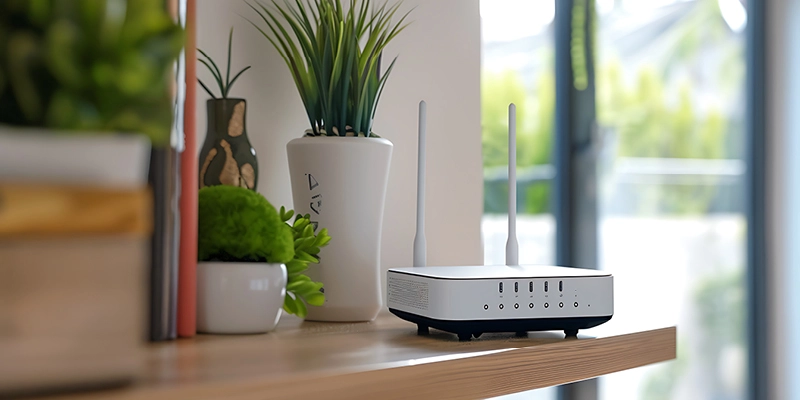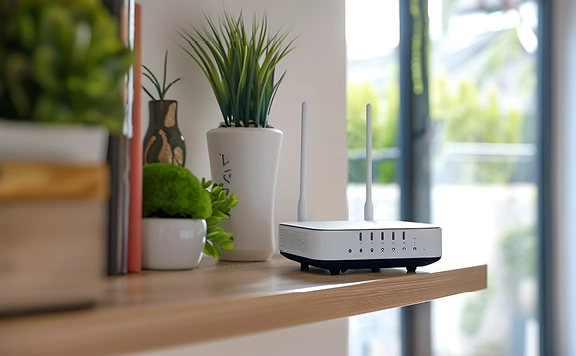How mesh networks work: A guide for smart home energy control
Smart homes are getting more sophisticated, with ways to save energy and help lower your electricity bill among their advantages. Mesh networks help smart devices work together so you can make the most of them.



How mesh networks work: A guide for smart home energy control
Smart homes are getting more sophisticated, with ways to save energy and help lower your electricity bill among their advantages. Mesh networks help smart devices work together so you can make the most of them.
Mesh networks didn’t get that name by accident. You can think of a mesh network like a series of little units spread throughout a space to make your home's Wi-Fi signal work better.
Mesh networks work behind the scenes to keep your smart devices working together. The better you understand how they work, the more you can get out of your smart home.
Like a team of Wi-Fi routers working together across your home, a mesh network carries a signal more reliably than a single wireless router doing all the work. Several smaller access points, called “nodes,” are used to create a web of coverage. It’s all designed so no area of the house gets left in a signal dead zone.
Smart home devices like thermostats, smart plugs and energy monitors track your usage and help you use less power. To do that, though, they rely on a steady Wi-Fi connection. Mesh networks create that strong, steady signal throughout your home to keep all your energy-saving devices online and working together uninterrupted.
Without these networks, your smart tools can lose their wireless connection and compromise your system’s performance. That can harm your smart home’s efficiency and even its overall functionality, potentially costing you.
When it comes to traditional Wi-Fi connections, your main router may not even reach every room, especially in larger homes with multiple floors or thick walls. A weak signal ⏤ or no signal ⏤ can disconnect the entire system, taking down all of your devices with it.
What does a day in the life of a smart home with a mesh network look like? Let’s examine key benefits of stabilizing your home’s Wi-Fi.
When all your devices stay connected without disruption, they can send real-time data without delays. That leads to more accurate energy reports you can actually use to lower your utility bills.
Your smart thermostat is one of the most important devices for keeping your energy bills low, and it relies on info from around your home (like room occupancy or outdoor temperatures). A mesh network helps your smart thermostat respond faster and more accurately to such variables.
Not all mesh networks are the same. A network designed for a small apartment might fall short in a large home. Here’s how to choose a mesh network that gives you the best coverage and energy-saving performance for your smart home devices:
Before you buy, think about the size and shape of your home. Where does your Wi-Fi usually drop? Are there thick walls, long hallways or multiple floors?
Here’s a rough guide to how many mesh nodes you might need:
Tip: To choose the best node placement, try walking around your home with your phone to test where the signal drops or gets weak.
Not all smart devices connect the same way. Older thermostats, plugs or cameras might only work on a 2.4 GHz band, while newer ones can handle 5 GHz or even Wi-Fi 6.
Before buying a mesh system:
Your home’s network handles sensitive information: when you’re out, how much energy you use and what devices you’re running. Strong security built into your mesh network isn’t just a bonus with this kind of data ⏤ it’s a must.
Look for these key security features when comparing mesh systems:
Most mesh systems are designed for easy setup, but some situations call for extra help. So, how do you decide whether to DIY or bring in the professionals?
Go DIY if:
Hire a pro if:
Once your mesh network is up and running, a little fine-tuning can go a long way. The energy-saving tips that follow help make sure your energy devices stay connected and responsive.
Your household devices and thermostat don’t use a lot of bandwidth on their own, but they do need a reliable internet connection.
To keep energy devices running smoothly:
Firmware updates aren’t just about getting the latest and greatest features — they’re critical for your security and smart home performance.
Here’s how to keep your system up to date:
Even if you’re just getting started with your smart home setup, it’s important to think ahead.
Here’s how to keep your mesh network ready for scalability:



Even strong networks can run into hiccups. Here’s how to spot and fix common mesh network issues that affect your energy devices:
If one of your devices keeps disconnecting, don’t panic. Try these steps:
Laggy smart home? Combat latency issues by balancing your devices across your available channels.
Here’s how:
Once you’ve found the right mesh system, the next step is making sure it’s matched with an energy plan that's just as smart as your home. Some plans offer perks like usage tracking, time-of-use rates or renewable energy options so your devices can help you save even more.
When choosing a plan, consider these questions:
The right energy plan provides your mesh-powered smart home with the flexibility and control it needs to operate at its best.
Explore options from Reliant
Smart home energy systems need a reliable wireless network to keep devices like thermostats, smart plugs and meters connected and automated. If the network drops, these tools can’t communicate or adjust in real time, which means less control and higher energy waste.
A mesh network enhances the performance of smart thermostats and HVAC systems by maintaining a stable connection across your whole home. These mesh units are especially helpful in dead spots like garages, basements or attics to give you faster temperature changes, better scheduling and more accurate data.
Signs that your smart home needs a Wi-Fi mesh system upgrade include frequent dropouts, apps lagging and responding slowly and smart devices randomly disconnecting. These are clues that your current setup isn't strong or wide-reaching enough to support your devices.
Mesh networks integrate with smart meters and energy monitoring systems by maintaining a strong, stable connection. This ensures your smart meter can transmit accurate energy usage data without interruption, giving you a clearer view of your consumption patterns.
Security features to look for in a mesh network system include WPA3 encryption, automatic firmware updates, built-in device management and guest network options. These help protect your personal data and prevent unauthorized access to your smart home.
Yes, mesh networks can help reduce your electricity bill. By keeping smart devices connected and running efficiently, you can support features like automation and scheduling, which make it easier to use energy wisely and avoid unnecessary consumption.
The number of mesh nodes you need depends on your home’s size and layout. Generally, you’ll need one node for every 1,500 to 2,000 square feet. Homes with multiple stories, thick walls or separate structures like a detached garage may need additional nodes.
During a network outage, some smart energy devices may continue to operate on backup settings, but others may lose functionality until the network is restored. A mesh network can improve overall reliability and often recovers quickly after brief outages.
To choose the right mesh network brand, look for options that offer strong coverage, easy mobile app control, compatibility with your current devices and support for emerging smart home standards. Bonus points for brands with excellent customer support and a straightforward setup process.
Select a category from the dropdown menu.